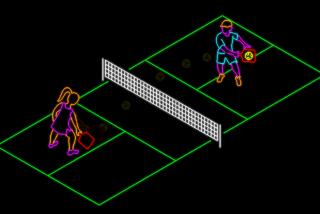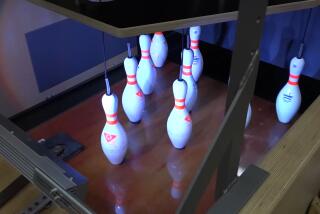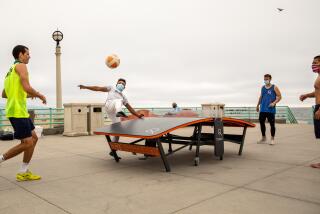Wallyball: Whole New Ballgame : Enthusiasts Go to the Wall to Add Spin for Hybrid Sport
- Share via
It’s not quite volleyball, and it’s certainly not racquetball. But it’s something like volleyball, and it’s played on a racquetball court.
“It’s like playing volleyball in your bedroom,” said one convert to the new hybrid sport called wallyball . That’s the feeling wallyball players get when the walls seem to close in on them.
Use a slightly smaller, softer, rubber-textured wallyball, string an 8-foot-high net across a racquetball court and you have the makings of wallyball.
It’s the walls that give wallyball its name, its character and its fun. The walls put a spin on the sport of volleyball that “humbles the best of (volleyball) players,” says Pete Martinez, recreation director at the Thousand Oaks Community Center. The wallyball caroms off walls, intentionally or not, at weird and unpredictable angles, creating ample opportunity for farce among inexperienced players.
Requires Finesse
“The big bashers who come into wallyball from volleyball find out wallyball requires more finesse,” says Martinez. Rules allow hitting the ball off one wall per hit; if it hits two walls or if it hits the opponent’s back wall at all, a point goes to the other team. Hence, any similarity to the wall-bashing sport of racquetball diminishes.
Wallyball can be played with teams of two, three or four. The game proceeds much like volleyball. After the serve across the net, the opposing team can hit the ball as many as three times. Any or none of the hits can be off a wall. Smart players set the ball up to one another, culminating in a “kill,” or final hit, that the team with the ball hopes will be unreturnable.
The nature of the kill can be quite different in wallyball than volleyball.
Walls Come Into Play
Again, the walls form the crux of the game. A wallyball kill might be a downward smash off a wall. It might also be a “dink” off a wall, designed to nick the wall and die before it can be dug out by an opponent. Clever players will add a bit of spin to the ball, just to confuse the issue.
And wallyball can get confusing. Or at least confounding. “If you want to look really foolish, play wallyball,” one Thousand Oaks player says. Martinez, who has been playing wallyball for five years and organized a Friday night league in Thousand Oaks, says he’s never seen a game in which a player didn’t catch a wallyball in the face or head at least once, the result of misjudging a carom.
“You almost always hear laughter on the court,” Martinez says. “It tends to be a more casual game than league volleyball or basketball.”
Wallyball is the creation of Joe Garcia, who in 1979 was managing a racquetball facility in Calabasas and looking for a way to fill up empty court time. He set about trying to devise new games that could be played on a racquetball court. One day Garcia and some workmen played around with a volleyball on an empty racquetball court, and Garcia realized he was onto something. He also realized that his volleyball-with-walls would be like a pinball game unless he limited the number of walls the ball could strike. He also had to limit the number of players on the smaller court.
Refinements ensued, and by the end of 1979, Garcia formalized the rules, registered the name and started Wallyball Inc.
Sports companies like Voit and Mizuno began making official blue wallyballs, and racquetball court managers, like Garcia, found they could fill otherwise dead time.
The game has a small but growing number of participants nationwide. President Bush reportedly has taken a fancy to the game and plays for relaxation at Camp David. Many racquetball courts in Southern California make at least one court available for wallyball.
A hotbed for wallyball is Holiday Harbor Racquetball Club in Marina del Rey, where half the courts are outfitted for wallyball. A footwear store in the Marina has organized a Wednesday night league at Holiday Harbor. The league season began Wednesday and runs through Nov. 15. Friday night is drop-in wallyball night at Holiday Harbor, when players can get involved in informal play.
According to league co-manager Dan Brown, the Wednesday night games can be very competitive. “We have some beach pros and former collegiate players in the A division; these folks take the game pretty seriously,” Brown says.
However, B and C divisions provide places for players of less ability. The Holiday Harbor league is composed of 24 three-person, co-ed teams. Teams of four play in the Thousand Oaks Friday night league.
For information on the Starting Line league, call (213) 827-3035. For information on the Thousand Oaks league, call (805) 492-2461. Or contact your local racquetball court or community center.
More to Read
Go beyond the scoreboard
Get the latest on L.A.'s teams in the daily Sports Report newsletter.
You may occasionally receive promotional content from the Los Angeles Times.










